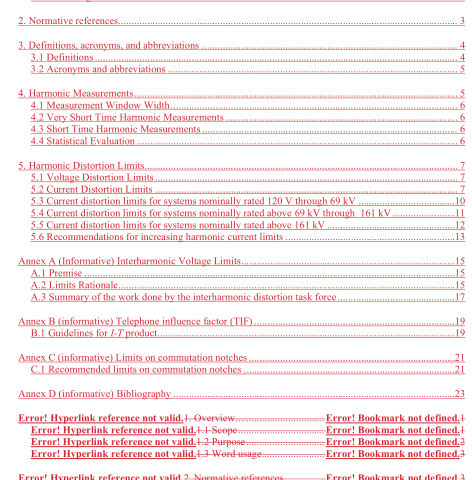IEEE P519/D7-2022 pdf download.Draft Standard for Harmonic Control in Electric Power Systems
1.2 Purpose This standard is to be used for guidance in the design of power systems with nonlinear loads. The limits set are for steady state operating conditions. In any casc, the limit valucs given in this document should not be considered binding in all cases. Some conservatism is present that may not be necessary in all cases.
This standard shall be applied at a point of como+ eupling 4PCC+ between system owners or operators and users in the power system. The limits in this standard are intended for application at a PCC between the system owner or operator and a user, where the PCC is usually taken as the point in the power system closest to the user where the system owner or operator could offter service to another user. Frequently for service to industrial users (i.e. manuficturing plants) via a dedicated service transtformer, the PCC is at the HV side of the transformer. For commecial users office parks, shopping malls, etc. ) supplied through a common service transformer, the PCC is commonly at the LV side of the service transformer.
The limits in this standard represent a shared responsibility for harmonic control between system owners or operators and users. Users produce harmonic currents that flow through the syste owner’s or operator’ s systerm which lead to voltage harmonics in the voltages supplied to other users.
The amount of harmonic voltage distortion supplied to other users is a function of the aggregate ffects of the harmonic current prodlucing loads of all us8ers and the impedance characteristics of the supply system. Hamnonie voltage distortion limits are provided to reduce the potential ncgative efects on user and system equipment. Maintaining harmonic voltiges below these levels nessitates that;
All users limit their harmonic current emissions to reasonable values determined in an equitable manner based on the inherent ownership stake each user has in the supply system and Each system owner or operator takes action to decrease volage distortion levels by modifying the supply system impedance characteristis as necessary. In order to allow the system owner or operator to control the system impedance characteristics to reduce woltage distotion when nessary, users should not add passves equipment that afects the impedance characteristic in a way such that voltage distortions are increased.
In efct, such actions by a user could amount to producing excessive voltage harmonic distortion. Such pasive equipment additions (hat lead to undesirable system impedance characteristics) should be controlld by the user in the same manner as current harmonic-producing devices operated by the user.
1.3 Word usage
The word shall indicates mandatory requirements strictly to be followed in order to conform to the standard and from which no deviation is permitted (shall equals is required t0).12 The word should indicates that among several possibilities one is recommended as particularly suitable, without mentioning or excluding others; or that a certain course of action is preferred but not necessarily required (should equals is recommended that).
The word may is used to indicate a course of action permissible within the limits of the standard (may equals is permitted to). The word can is used for statements of possibility and capability, whether material, physical, or causal (can equals is able to).
2. Normative references
The following referenced documents are indispensable for the application of this document (ie, they must be understood and used, so each referenced document is cited in text and its relationship to this document is explained). For dated references, only the edition cited applies. For undated references, the latest edition of the referenced document (including any amendments or corrigenda) applies.IEEE P519/D7 pdf download.IEEE P519/D7-2022 pdf download
IEEE P519/D7-2022 pdf download

Leave a Reply